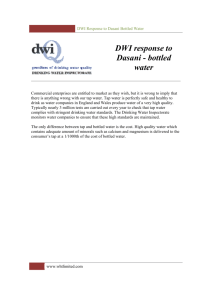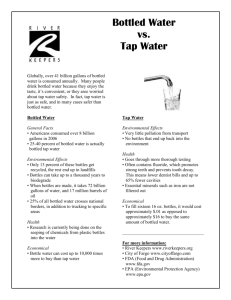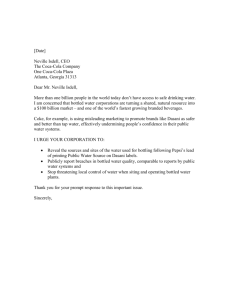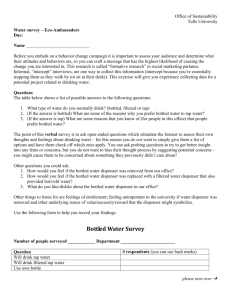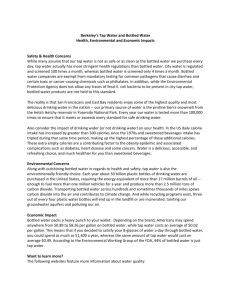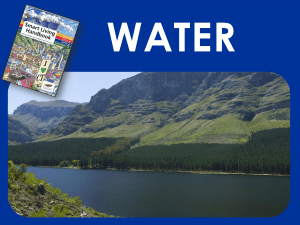Big Bottle or Tested Tap?
advertisement
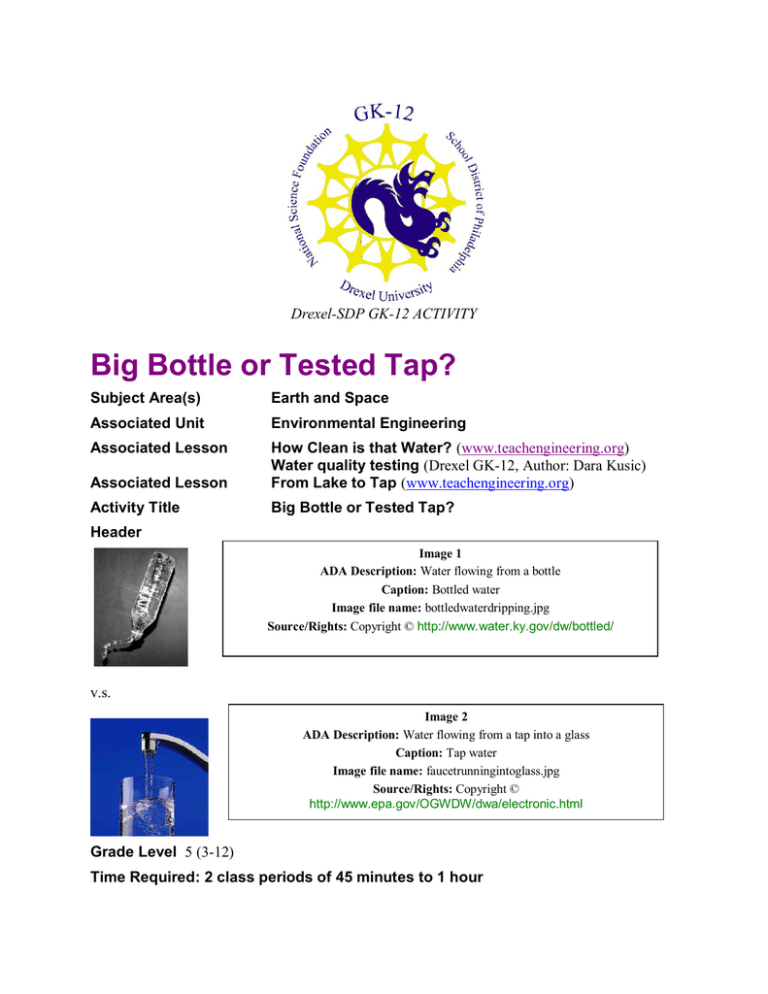
Drexel-SDP GK-12 ACTIVITY Big Bottle or Tested Tap? Subject Area(s) Earth and Space Associated Unit Environmental Engineering Associated Lesson Associated Lesson How Clean is that Water? (www.teachengineering.org) Water quality testing (Drexel GK-12, Author: Dara Kusic) From Lake to Tap (www.teachengineering.org) Activity Title Big Bottle or Tested Tap? Header Image 1 ADA Description: Water flowing from a bottle Caption: Bottled water Image file name: bottledwaterdripping.jpg Source/Rights: Copyright © http://www.water.ky.gov/dw/bottled/ v.s. Image 2 ADA Description: Water flowing from a tap into a glass Caption: Tap water Image file name: faucetrunningintoglass.jpg Source/Rights: Copyright © http://www.epa.gov/OGWDW/dwa/electronic.html Grade Level 5 (3-12) Time Required: 2 class periods of 45 minutes to 1 hour Group Size: 4 students or less Expendable Cost per Group: $3/group for 7 groups/class Summary The goals of this activity are twofold. First students will be introduced to some measurable indicators of water quality. They will use both the measurable indicators as well as their own assessment of taste and odor to rank several types of bottled water. Then students will consider a life cycle assessment (LCA) approach to compare bottled water and tap water. The goal of LCA is to compare the full range of environmental and social damages associated with a product or service, to be able to choose the least burdensome one. Engineering Connection Water quality management is an important area in which environmental engineers work. While source water is obtained through many different places including lakes, streams, rivers, and wells, the goals of treatment are to provide a safe product for consumption. In the United States, the Environmental Protection Agency sets standards for drinking that must be met. Engineers work to continuously improve the systems and processes in place to remove a growing number of contaminates from our water supply and to ensure quality and safety. Keywords Water quality, environmental engineering, life cycle assessment, drinking water Educational Standards Environments and Ecology: Renewable and nonrenewable resources 4.2.A. Uses, 4.2.B. Availability, 4.2.C. Management, 4.2.D. Influential factors Environmental Health 4.3.A. Environmental health issues, 4.3.B. Human actions, 4.3.C. Biological diversity Humans and the Environment 4.8.A. Societal needs, 4.8.B. Sustainability, 4.8.C. Human impacts, 4.8.D. Supply and demand Science: Technology Education – Science, Technology and Human Endeavors – Meeting Human Needs 3.8.B, Science, Technology and Human Endeavors – Consequences and Impacts 3.8.C Math: Computation and Estimation 2.2 Pre-Requisite Knowledge Students should have some basic knowledge of chemical elements and compounds, water quality criteria and testing. They can get this from one of the associated lessons. Learning Objectives After this lesson, students should be able to: Describe some water quality indicators Itemize some of the pros and cons of bottled water Explain what is meant by ‘life cycle analysis’ or ‘cradle to grave analysis’ Materials List Each group needs: a minimum of 14 test strips for water quality – Hach 5 in 1 are recommended, but you can use a variety of others 2 a minimum of 14 cups for testing Hach 5 in 1 Water Quality Test Strips (~$14/50 strips) To share with the entire class: pH meter Water testing kit Mineral water can be sparkling (bottled) Spring water (bottled) Tap water drawn immediately before the experiment Tap water drawn at least 8 hours before the experiment and keep cold Purified drinking water (bottled) Distilled water (bottled) Collected rain water Soda, fruit punch like Hi-C or Capri Sun or any other beverage commonly consumed by the class Introduction / Motivation Bottled water cost more than tap water and produces more waste, but even in a country where we have clean, extremely cheap drinking water distributed to almost every house, the bottled water industry continues to thrive. Why? [Let students share their opinions about quality.] Tap water is regulated more stringently, meaning that there are certain health standards that it has to meet. It also produces less waste than bottled water. Tap water doesn't have to be trucked, or bottled; and it does not come into contact with contaminants like plasticizers. It has a considerably smaller “carbon footprint” than bottled water, and you don't have to worry about disposing of plastic bottles. Despite these facts, people choice bottled water for a variety of reasons including taste and odor every day, but sometimes it‟s because they presume it is of better quality than tap water. Bottled water is often compared to tap water as if they are in competition, but actually bottled water is in competition with other bottled beverages not with tap water. 3 You can‟t tell much about the quality of water simply by looking at it; most pollutants are invisible to our eyes. Tap water has to meet certain maximum levels of chemical constituents and naturally occurring microorganisms. Here are some other facts to consider about tap water: 1. Tap water is tested daily- it is protected by the Safe Drinking Water Act; water suppliers are required to provide an annual report on the quality of your local water and to test tap water daily. 2. Tap water is inexpensive 3. Tap water contains fluoride to prevent tooth decay. 4. Tap water is often tasty – if you don‟t like the flavor you can filter it using an in home filter at a very low cost compared to bottled water. Here are some other facts to consider about bottled water: 1. The FDA examines bottled water only weekly, and consumers can‟t get the agency‟s results. 2. Bottled water costs about 500 times more than tap. 3. Bottled water contains less fluoride than tap water. 4. Bottled water is convenient to carry around. See if you can come up with some other facts about the two types of water we‟re discussing. [Allow students to make a list containing their own opinions and knowledge. For ideas use the following chart which is found at http://www.communitywater.com/core/content_tapvsbottled.htm] Tap Water Regulated by EPA Bottled Water Regulated by FDA Cannot have confirmed E. coli or fecal Coliform bacteria. A certain amount of any bacteria is allowed. Filtered and/or disinfected No federal filtration or disinfection requirements. Violation of drinking water standards are grounds for enforcement. Bottled water in violation of standards can still be sold. Utilities must have their water tested by certified labs. Such testing is not required for bottlers. Tap water results must be reported to state or federal officials. There are no reporting requirements for bottlers. Water system operators must be certified. Bottled water plant operators do not have to be certified. Water suppliers must issue consumer confidence reports annually. There are no public right-to-know requirements for bottlers. Costs pennies a day Costs $.80 to $4.00 per gallon. Contains essential nutrients for the body such as calcium and iron. Natural minerals are removes by filtration. Chlorine residual in water to prevent bacteria growth. No disinfectant present to kill bacteria in bottles. 4 Today, we will explore the differences between tap and bottled water based on some indicators of water quality. We will also complete a life cycle assessment for each. Vocabulary / Definitions Word Definition The investigation and valuation of the environmental impacts of a given product or Life Cycle Assessment service caused or necessitated by its existence; often called cradle to grave analysis A number between 0 and 14 on a scale used to indicate the acidity of a water sample. pH Water The physical, chemical, and biological properties of water; variables that are quality measured to determine the condition of a water body. Hard water Water that has high mineral content (mainly calcium and magnesium ions) (Hardness) Alkalinity A measure of the ability of a water to resist changes in pH Carbon The total set of greenhouse gas emissions caused by an organization, event or footprint product Procedure Background Students should have a discussion or lesson (like one of the associated teachengineering.org lessons) that introduces them to water quality indicators. The Hach strips can provide the following measurements. Free Chlorine (0-10 mg/L) Total Chlorine (0-10 mg/L) Total Hardness (as CaCO3, 0-25 gpg and 0-425 mg/L) Total Alkalinity (as CaCO3, 0-240 mg/L) pH (6.2 - 8.4) With the Students Part 1 Ask the students to record their notes and measurements in a notebook or journal. Step 1: Demonstrate the how to use the testing strips, kit and pH meter for the entire class using a beverage other than water. Step 2: Distribute 2 or more samples to each group so that each water type is tested by at least two groups. Step 3: Test the pH and quality of each sample using your testing kit or strips. Step 4: Record the values. Step 5: Share results in a master chart on the board. Step 6: Allow student to test several types of water (DO NOT INCLUDE RAIN WATER OR ANY OTHER UNTREATED WATER IN THIS TEST.) Step 7: Tally the students‟ opinion of taste. This will be accomplished easiest by taking a vote of good or bad by a show of hands for each type tested. 5 Step 8: Compare the quality of the water based on the measurements taken above. Also compare the water to the other beverage based on the measurements. Talk about what has been removed from the bottled water. Part 2 Go back to the comparison chart between tap and bottled water. Have students list the life cycle of tap water and bottled water from „cradle to grave‟. These lists should include, but are not limited to the following: Tap Water: 1. Capture from source – usually surface water in an urban area, i.e. river or lake 2. Pump through existing pipes to a treatment plant 3. Treat the water to remove contaminants 4. Chlorinate the water to prevent future microbial growth 5. Distribute through existing network to homes 6. Drink Bottled Water: 1. Capture from source, i.e. river, lake, groundwater (spring), etc. 2. Pump to manufacturing plant 3. Treat if necessary 4. Bottle 5. Package 6. Distribute to stores 7. Purchase by consumer 8. Transport home 9. Drink 10. Dispose of bottle 11. Transport to recycling center or landfill Discuss the implications of cost and energy usage during the life of each type. Investigating Questions Are there pros and cons to both tap water and bottled water? Can you list 3 of each? A carbon footprint is "the total set of greenhouse gas emissions caused by an organization, event or product." Which type of water has the biggest carbon footprint? Assessment Pre-Activity Assessment None Activity Embedded Assessment Quality of participation during discussion. Post-Activity Assessment Have the students describe which type of water they think is better based on the results of the water quality tests and the life cycle assessment. 6 Activity Extensions 1. Have the students do an online search to find details related to their own local drinking water or across the country. Have the students report back with specific information including: Source of the water Treatment steps taken Sources of pollution Etc. Try links like: http://www.ehso.com/ehshome/DrWater/drinkingwater.php http://water.usgs.gov/nawqa http://www.epa.gov/safewater 2. Take a field trip to a local stream or river. Allow the students to do sampling and testing in the field using their kits. Participate in a program like the World Water Monitoring Day: http://www.worldwatermonitoringday.org/Test_Kits/Kits_Main.html References U.S. Department of the Interior, U.S. Geological Survey Persistent URL: http://pubs.water.usgs.gov/fs02701 Owner Drexel University GK-12 Program Contributors Jade Mitchell-Blackwood Copyright Copyright 2010 Drexel University GK-12 Program. Reproduction permission is granted for nonprofit educational use. 7
